|
|
Our Publicity Officer Tony Russell (UK) seems to be on the lookout for
photos of unusual cars, and wondered if we knew what make this vehicle was
which has connections with the London to Brighton Veteran Car Run? - Yes,
- this is the winner of the 1927 'Old Crocks Race to Brighton' organised
by the Daily Sketch and Daily Graphic newspaper and the Autocar magazine
on the 13th of November 1927. The car was reported as being a '1896
Panhard', but was actually an 1899 Clement Panhard VCP Phaeton. The
vehicle was designed by the prolific French inventor in airships,
submarines and automobiles, Arthur Krebs, who subsequently licensed the
design patents to Emile Levassor, and also later joined Panhard & Levassor.
This is also one of a number of vehicle brands
that the French automobile pioneer, Adolphe Clement, was involved with at
the dawn of French motoring. While he was the chairman of Panhard & Levassor
it became obvious that the company would not have the capacity to
manufacture this vehicle at the anticipated quantity of at least 500
units, so Clement agreed to manufacture some of the vehicles under licence
in his factory in Paris, Levallois Perret, as Voiture Clément-Panhard (VCP).
Krebs had developed the engine specifically for this vehicle, a single
cylinder four-stroke with a displacement of 763cc, the cylinder cooled
with air, but the cylinder-head with water. No accelerator pedal, the
engine ran constantly at maximum power on both petroleum and gasoline.
Initially hot tube, later electric ignition. First series engine produced
3.5 hp, and from 1901, it had an output of 4.5 hp. The engine was rear
mounted at a slight incline. The gearbox was initially constant-mesh
electromagnetic, subsequently a mechanical version, later with a reverse
gear. Speed rated at 35KPH.
|
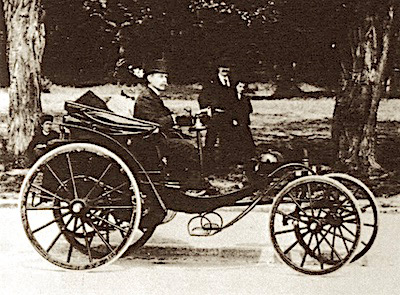
1899 Krebs automobile with A C Krebs driving
|
|
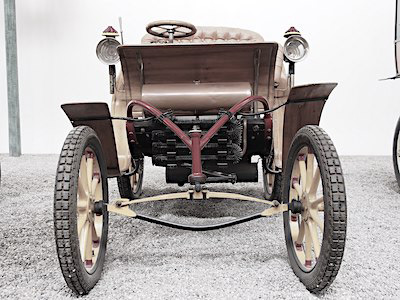
Front of a 1900 Clement Panhard VCP
showing the front axle, transverse suspension and central steering
|
The most noticeable aspect of the car was the central pivot steering
system, rather than Ackermann. Steering was from a steering wheel via a
link arm to the front suspension. The suspension was by a transverse leaf
spring across over the whole of front axle which rotated within a
centrally vertical steering tube. On the rear, it had a pair of
longitudinal elliptic springs fitted to the rear axle. Originally the
body was only available as a Phaeton but in 1900 a three-seater vis-à-vis
variant was added. In many ways this car was very similar to the 1906 Ford
Model N. Serial numbers started at 101 finished in 1902, with about 600
made. The car was also licenced to be manufactured in Scotland by the
Sterling Motor Carriages, who made an additional 200 with own bodies
distributed world-wide.
The car in the picture above, the 1899 Clement
Panhard VCP Phaeton taking part in the 1927 Brighton Run, had the chassis
number 210 and engine number 2011. The car was registered V 46 which was a
Lanark County Council registration from Scotland, issued very early in
1904. The vehicle is shown being driven by the winning driver, John Bryce
of Lanark.
The 1927 Run was the first of the series of 125+ recent annual Brighton
Runs and was organised by the Daily Sketch and Sunday Graphic newspaper
and the Autocar magazine. The event was intended as a relatively
light-hearted jaunt officially named the 'Old Crocks Race to Brighton'.
The idea was to get some of the old bangers out of retirement and back on
the road after resting since the original Brighton Run in 1896. Cars
had to be at least 21 years old and had to comply with then legal and
licencing requirements. Each car carried a huge board advertising the
newspapers concerned, and participants were encouraged have comical
slogans on the cars and to wear comical clothing. The event also included
possible promotional work for a film 'The First Auto' where the
prize-winner would receive a respray. It may be noted that this was some 25 years before the Brighton film 'Genevieve'.
|
|
Prior to the
Brighton run, the majority of the cars which were entered also took part
in the London Parade Run. The Daily Sketch newspaper had organised a
'Procession of Ancient Motor Cars' from its offices in Fleet Street, to
the Motor Show at Olympia, awarding entrants with prizes. It was reported
that many of the cars were surprisingly still operable and some were still
in daily use as taxis.
The 1927 'Old Crocks Race' event would be won on a basis of points awarded
for the age and the power of the vehicle, originality, condition, whether
there were involuntary stops en-route, and points lost for any available
seat in the car being unoccupied. To discourage cheating, observers from
another competing car were passengers and it was their responsibility to
keep a tally of the points, and their diligence would be rewarded by a
free seat at the official dinner. The Start was subsequently moved to the
Embankment near New Scotland Yard and then out across Westminster Bridge. The
designated Finish point was the Old Toll House in Patcham, from where the
vehicles drove in a parade to Brighton. The 'Old Crocks Race' eventually
had 51 initial entries, 44 actual starters, 41 completed the course, 21
did so without stopping, and 37 were eligible for the gold medal. The
first prize was awarded to John Bryce who had also previously won the
prize money in the Olympia procession in the 1899 Clement Panhard VCP
Phaeton.
Although the 1927 'Old Crocks Race' was the rebirth of the London to
Brighton Run, the fun of the 1927 run soon began to become more serious
and, three events later, the Veteran Car Club was formed in 1930, which
now regulates, verifies and dates all participating cars. …Which is
perhaps just as well because stories had previously been circulating that
some of the participants in the original 1896 run had been pulled by
horses most of the way, some towed by bigger cars and that others had
loaded their cars onto the train in London and unloaded at Preston park,
then splashed them with mud before the procession into Brighton.
|
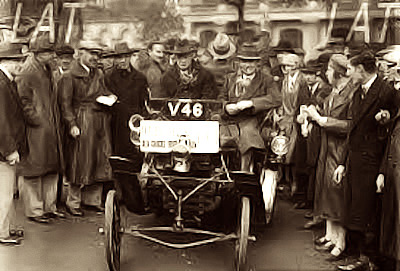
1899 Clement Panhard VCP Phaeton
driven by the winning driver,
John Bryce
of Lanark (left).
|
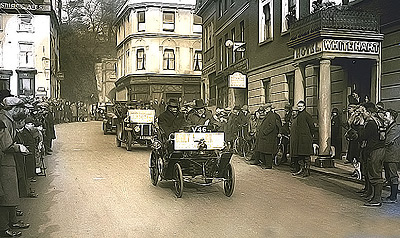
1899 Clement Panhard V 46 in Reigate for compulsory Lunch Stop.
Please note the Reigate tunnel in the background, which was
then a toll
tunnel on the main road running through the town,
now bypassed and closed. |
The very first London to Brighton Run was organised in 1896, still in the horse
era, by Harry J. Lawson and was named "The Emancipation Run" to
celebrate the recently passed Locomotives on Highways Act. This abolished
the need for a man being required to walk on foot 60 yards ahead of the
vehicle waving a red flag so as not to upset horses. The Act also raised
the national speed limit of 4mph in the country (2mph in town) to 14 mph
in the country.
The event started with a breakfast at the Charing Cross
Hotel after which the competitors gathered outside the Metropole Hotel to
be escorted from the start at 10.30 by a mass of cyclists enjoying the
then cycling boom, this being mirrored today by many penny-farthings
accompanying the car run to Brighton. A total of 33 motorists set off from
London for the coast, with a compulsory lunch stop in Reigate, and 17
arrived in Brighton. The first to arrive was a Duryea Motor Wagon, beating
the next by an hour.
A number of attempts were made to organise similar
runs in subsequent years without a great deal of success, and it was not
until 1927 that the first proper re-enactment took place. All subsequent
LBVC Runs are an annual anniversary of the original Run and are only for
cars that were in use THEN. These are now being called 'Veteran' cars. The
Run is open to four-wheeled cars, tri-cars and motor tricycles
manufactured before 1st January 1905 and that are subject of a valid
Veteran Car Club of Great Britain (VCC) Dating Certificate. Although the red flag man had actually been
abolished 1878, the Locomotive Act had remained known as the Red Flag Act.
Because of this, a red flag was ceremonially destroyed at the start of the
1896 run.
|
The LBVC Run distance is
now approximately 60 miles (97km) and historically
starts from Serpentine Road in Hyde Park in central London, and finishes
at the sea-front at Madeira Drive in Brighton. First cars start at
Official Sunrise Time (approx. 7.00am) and depart in batches at intervals
of two minutes. The starting order is determined by age and horsepower,
with earliest vehicles starting first. The maximum average speed permitted
is 20mph. The official finish is at Madeira Drive, Brighton which closes
at 4.30pm. The maximum entry list is 450. The current catalogue suggests a
slightly smaller overall entry list.
The Start in central London has now
been split into two routes to ease congestion and improve the flow of the
run within the city. This is why some cars carry blue entry numbers and
some a red number. The two routes join up again north of Croydon.
Most
British registered cars carry a brass plate indicating the official name
and date of the car as issued by the VCC. Those without such plate are
generally entrants from abroad, Europe and America.
Some cars are also
carrying a Red letter 'R' sign which denotes they are undergoing the
Regularity Time Trial of achieving an average speed as close as possible
to that nominated at the start of the event over a defined 10 mile stretch
of the route near Redhill. Points are lost for being early or late, and quite a few lost for hiding out of sight if early!
Nothing much changes!
Similar specilised Brighton Runs take place for early Motorcycles (Pioneer Run) and early Commercial
Vehicles (HCVS Brighton Run), and many one-make car clubs use the route as
does the London to Brighton Bicycle run. |
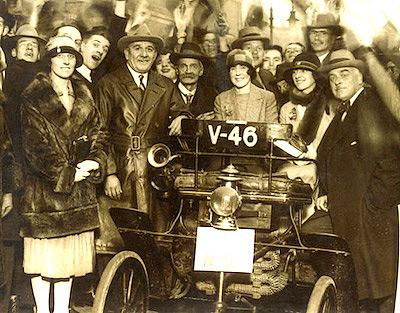
1927 Winner John Bryce (with moustache centre)
being fated by motoring personalities of the day. |
Go to Recent Venues Page
PICTURE GALLERY INDEX
|